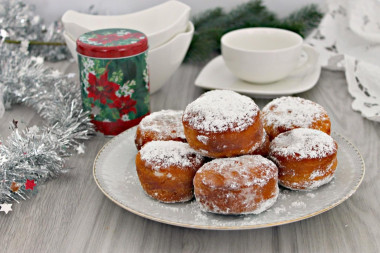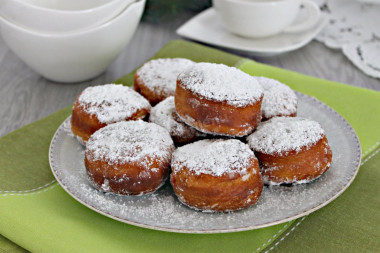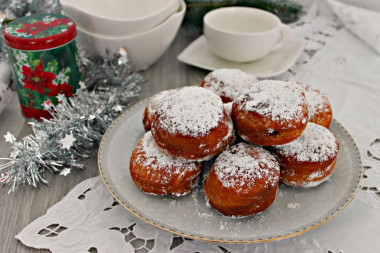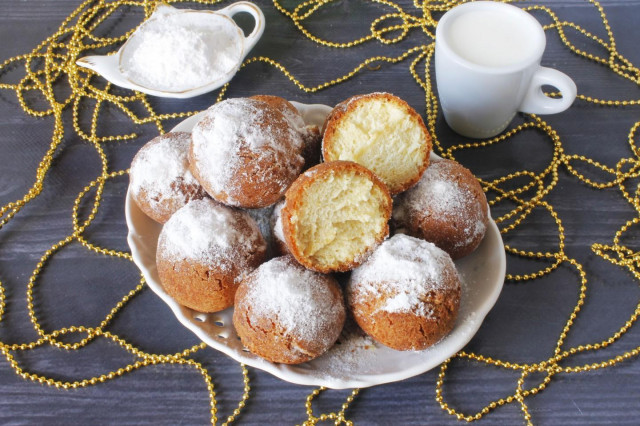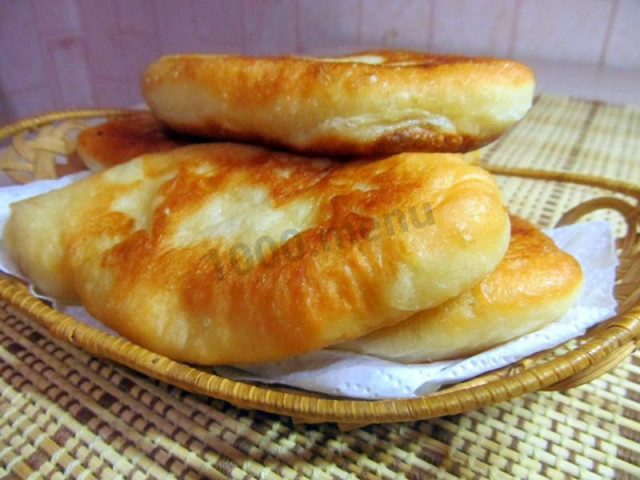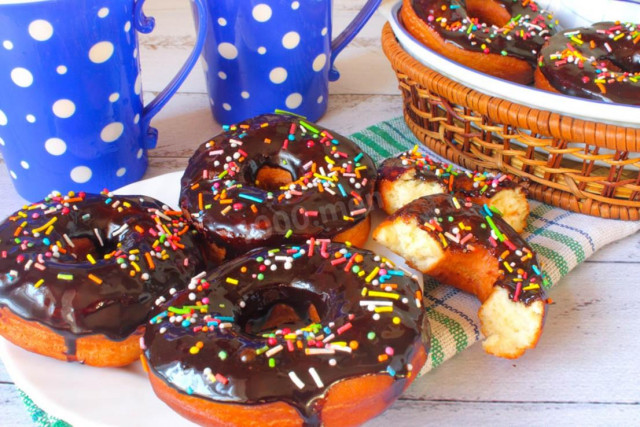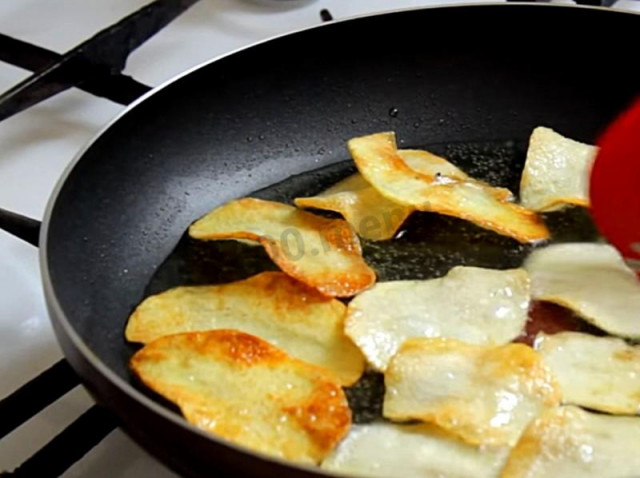Composition / ingredients
Step-by-step cooking
Step 1:
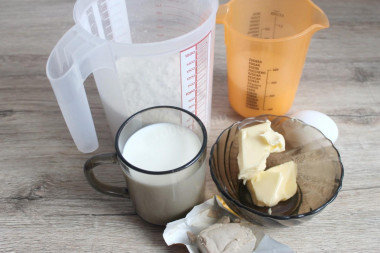
How do berliners make donuts? Prepare the necessary products. Preheat the milk in advance to a warm state. The remaining products should be at room temperature.
Step 2:

Pour the warm milk into a bowl, add yeast and two tablespoons of sugar to it. Add a little flour, about 1-2 tablespoons. This is our sourdough. After a while, she should rise with a cap. This means that we have working yeast, and they have been activated.
Step 3:
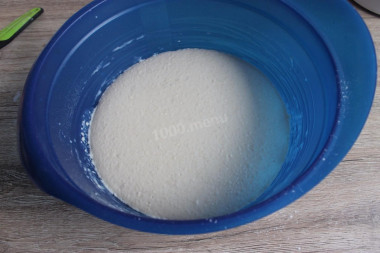
That's how my sourdough rose. Now add to it the melted butter, the remaining sugar, egg, salt and flour in parts. Please note that you may take more or less flour. Therefore, focus on the consistency of the dough. It should be moderately cool, but not too elastic and not sticky.
Step 4:

Knead the dough. Cover it with a towel and put it in a warm place for 1.5 hours or more. I need the dough to rise.
Step 5:
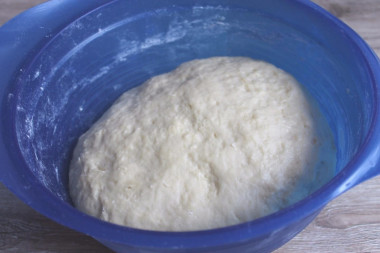
That's how it rose for me. Knead the dough with your hands again.
Step 6:

Sprinkle the work surface of the table with flour. Put the dough on the table. Roll it out one and a half cm thick . Squeeze out these mugs with the edge of the glass. Cover them with a towel and leave them to come up for an hour.
Step 7:
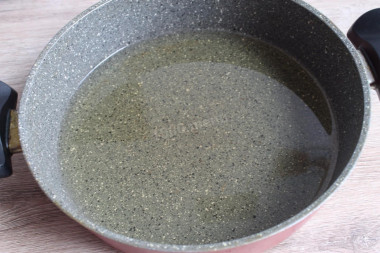
Preheat a frying pan on the stove. Add vegetable oil to it, wait until it becomes hot. To find out if the oil is hot enough, dip a wooden spatula into it. If there are bubbles around the blade, the oil is ready to work.
Step 8:
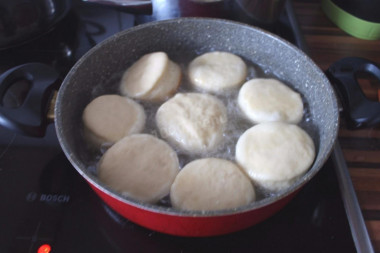
Fry the Berliners donuts on both sides until golden brown. Reduce the heat slightly. If the donuts are fried in very hot oil, then they will remain raw inside. Therefore, try not to heat the oil too much. If you have a thermometer, we need 170-180 degrees.
Step 9:
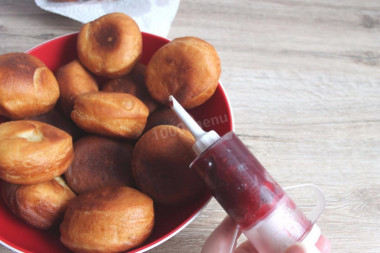
Put the finished donuts on a paper napkin so that the excess oil goes away. Take a cooking syringe. Fill it with jam (I have raspberry). Make a puncture on the side of the donut with a syringe and fill the donut with filling. Do it carefully. Instead of jam, you can use any sweet cream, boiled condensed milk, chocolate paste. Donuts in the process of filling should not be very hot - only warm.
Step 10:
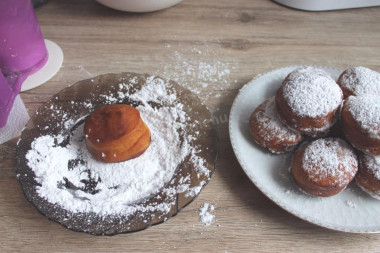
Sprinkle the doughnuts with powdered sugar inside. That's it, the Berliners are ready. Help yourself!
Step 11:

This is what doughnuts look like in a rift. They are lush and soft.
Excellent German Berliners. These doughnuts are also called Krapfen (that is, crumpet). They were invented back in 1756. German and Polish chefs are still arguing about who invented them first. Polish donuts have more jam inside. Both are prepared very simply, and the taste is delicious.
The liquid in which yeast is bred should be pleasant to the touch, no higher than 40 degrees. Why is this important? In a warm environment, yeast is well activated, in a hot one it will die, and in a cold one it simply will not work. To avoid unpleasant surprises, check the yeast before mixing with the rest of the ingredients. Pour a little warm milk into a bowl, stir in the yeast. Cover the bowl with a kitchen towel and put it in a warm place without drafts for 10-15 minutes. During this time, a foam yeast cap should appear on the surface of the sponge. If this did not happen, then the fermentation process has not started (the yeast is overdue or spoiled). In this case, it is worth taking other yeast, otherwise baking will not work.
Be prepared for the fact that flour may need more or less than indicated in the recipe. Focus not on the amount of flour, but on the desired consistency of the dough. To avoid mistakes, read about flour and its properties!
Use oil with a high smoking temperature for frying! Any oils are useful only until a certain temperature is reached - the point of smoking, at which the oil begins to burn and toxic substances, including carcinogens, are formed in it.
Unrefined oils, with rare exceptions, have a low smoking point. There are a lot of unfiltered organic particles in them, which quickly begin to burn.
Refined oils are more resistant to heating, and their smoking point is higher. If you are going to cook food in the oven, on a frying pan or grill, make sure that you use oil with a high smoking point. The most common of the oils with a high smoking point: refined varieties of sunflower, olive and grape.
Caloric content of the products possible in the composition of the dish
- Whole cow's milk - 68 kcal/100g
- Milk 3.5% fat content - 64 kcal/100g
- Milk 3.2% fat content - 60 kcal/100g
- Milk 1.5% fat content - 47 kcal/100g
- Concentrated milk 7.5% fat content - 140 kcal/100g
- Milk 2.5% fat content - 54 kcal/100g
- Chicken egg - 157 kcal/100g
- Egg white - 45 kcal/100g
- Egg powder - 542 kcal/100g
- Egg yolk - 352 kcal/100g
- Ostrich egg - 118 kcal/100g
- Pressed yeast - 109 kcal/100g
- Whole durum wheat flour fortified - 333 kcal/100g
- Whole durum wheat flour, universal - 364 kcal/100g
- Flour krupchatka - 348 kcal/100g
- Flour - 325 kcal/100g
- Granulated sugar - 398 kcal/100g
- Sugar - 398 kcal/100g
- Butter 82% - 734 kcal/100g
- Amateur unsalted butter - 709 kcal/100g
- Unsalted peasant butter - 661 kcal/100g
- Peasant salted butter - 652 kcal/100g
- Melted butter - 869 kcal/100g
- Vegetable oil - 873 kcal/100g
- Apricot jam - 265 kcal/100g
- Pear jam - 268 kcal/100g
- Quince jam - 223 kcal/100g
- Apple jam - 265 kcal/100g
- Jam - 265 kcal/100g
- Salt - 0 kcal/100g
- Powdered sugar - 374 kcal/100g


